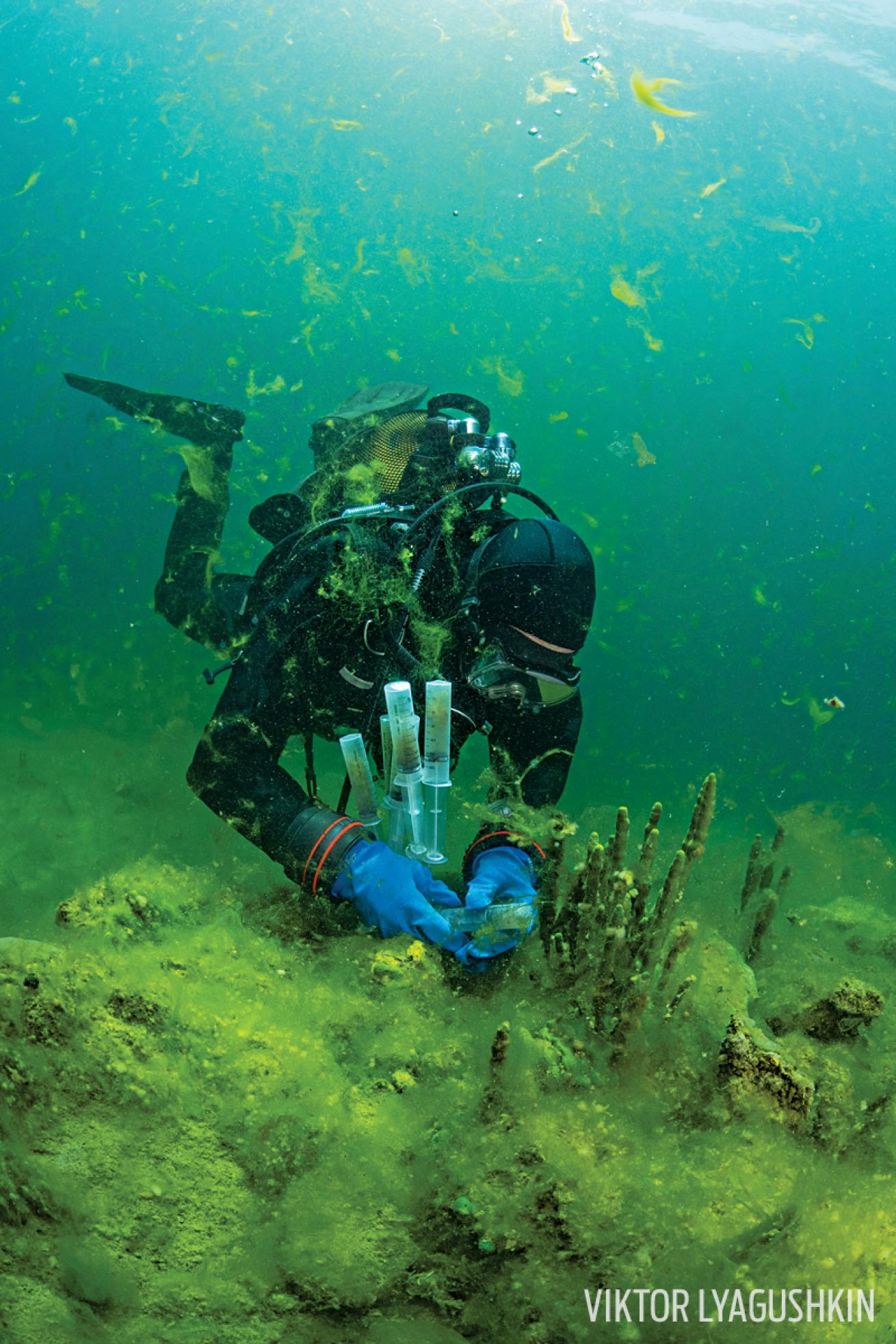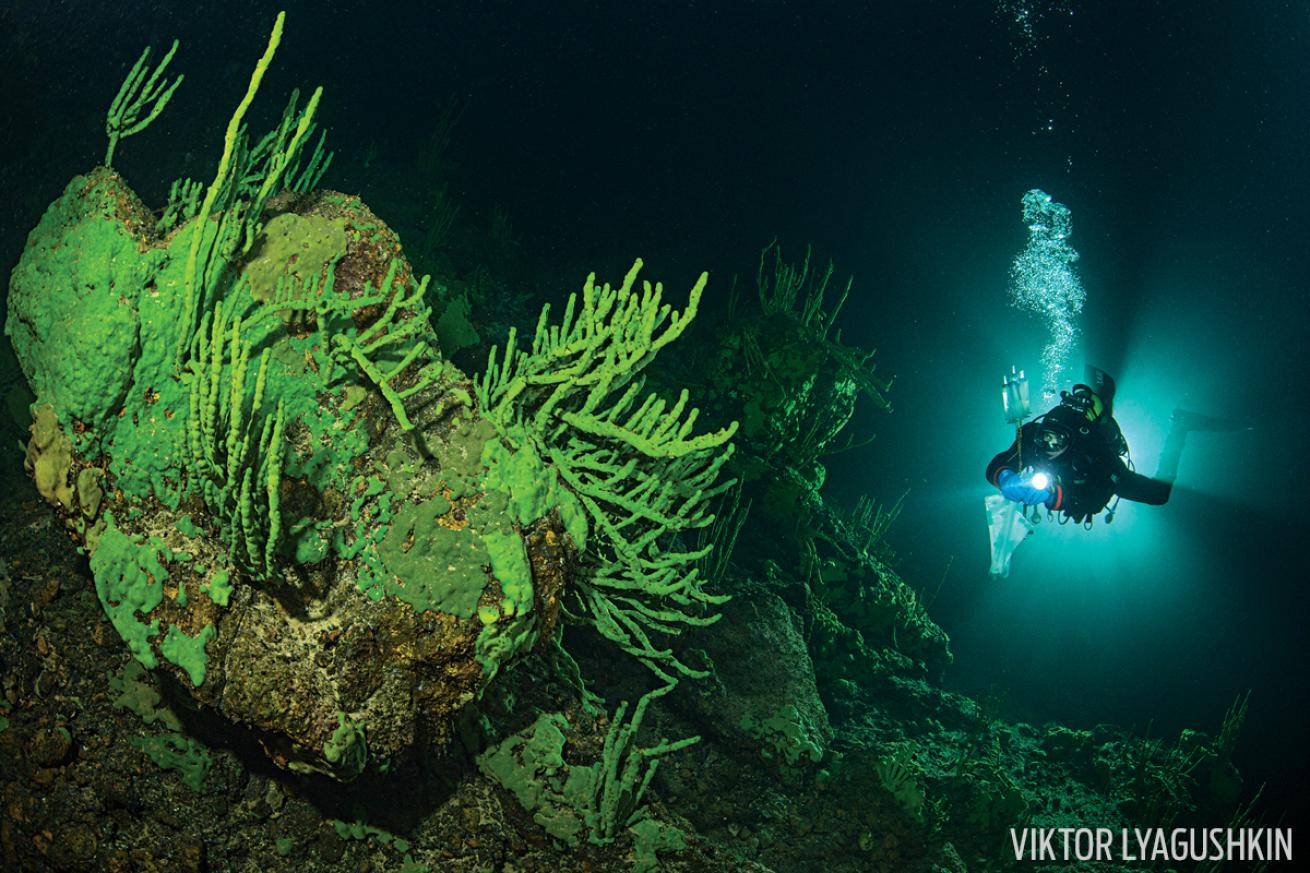Invasive Green Slime is Taking Over Lake Baikal

Viktor LyagushkinAs green slime takes over the world's largest freshwater lake, scientists are working to study the algae.
Jumping from the high board of scientific research vessel Titov into the frigid waters of Lake Baikal knocks the wind out of me. It’s June, but as 37-degree water seeps under my thick neoprene helmet, my lips become numb and the membrane of my regulator starts to rattle with the cold. Titov’s engine roars loudly and unpleasantly, but it becomes a beacon on our way back. A scientific team from the Baikal Limnology Institute and I check our equipment and start to descend into the depths, where the white flourish of a transect is visible, a marked rope that helps to compare conditions in different years at the same spot.
The water is absolutely clear, but the view is far from normal. Green slime is everywhere, a carpet stretching to the horizon; today only 13 percent of the lake shallows is free from it. We inspect the bottom near the town of Listvyanka, on the south side of the lake, in Russia’s “Baikal Riviera,” just north of the border with Mongolia; the tourist town is the most popular place on Baikal. The water is still as transparent as air, so guests here have no idea that the lake is not as clean as it seems.
The scientific team begins taking samples of water and algae and making photographs. During our three-week expedition, they will do from three to five dives per day, spending about five hours a day in the chilly waters, racing to complete their research of invasive Spirogyra algae before funds and warmer weather run out.
Back on Titov, they will have a couple of hours to eat and have a nap before the next dive. While they rest, their field laboratory investigates the samples, working to complete their tasks before divers bring them another batch.
For two years, Baikal Limnology Institute has devoted itself principally to exploring the issue of Spirogyra, a genus of filamentous, free-floating green algae that is strangling the world’s largest freshwater lake by volume.

Viktor LyagushkinThe lake is polluted due to growing tourist activity.
The root of the problem is growing tourist activity. Most settlements and campsites on the lakeshore have no sewage-treatment facilities. Those that do don’t meet established standards. As a result, the lake takes in too much human waste and detergent. For Spirogyra, it’s a paradise of nitrate and phosphate fertilizers.
Lake Baikal has a special composition: Its waters contain very little organic matter and a lot of oxygen, even more than in human blood by percentage. The slime Spirogyra stops the circulation of water at the bottom of the lake; oxygen in the bottom layer is quickly used up, and the spot becomes uninhabitable for native species.
Baikal is vast — the nearly 400-mile-long lake contains 20 percent of the world’s fresh water not locked in ice, more than the U.S. Great Lakes combined — and densely populated by various animals, but the number of “hot spots” of biodiversity in the lake is fewer than the fingers on a hand. Two percent of the lake’s area contains 90 percent of its species described to date, and all of those places are overgrown with slime. Increasing numbers of tourists means jobs and money for the region, and disaster for the lake.
Professor Dmitry Shcherbakov, the head of Baikal Limnology Institute’s genetics laboratory, has been working on Baikal since 1989. “It seems the alien algae has such a perfect genetic composition that it thrashes other lake inhabitants like a bully on the dance floor,” he says.
“In my opinion, a phase transition is occurring. Ecosystems can change their composition very quickly and very dramatically,” Shcherbakov says. “Where will it happen, and when? I’m not sure that there is a simple mathematical model that could predict that. But it is possible that an ecosystem can suddenly — bang! — change to a new one. This slime might become truly a Baikal species, but it will be a completely different Lake Baikal.”
See More Lake Baikal:
The 25 Best Freshwater Dive Sites
Secret Spot: Diving Lake Baikal
11 Amazing Underwater Photos That Will Make You Want To Travel The World










